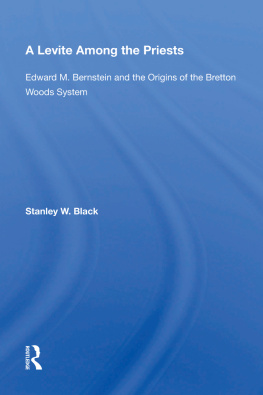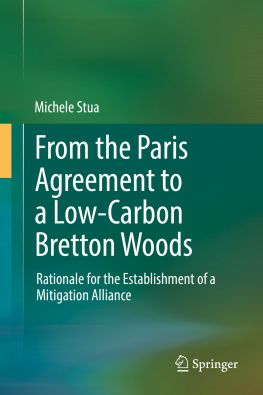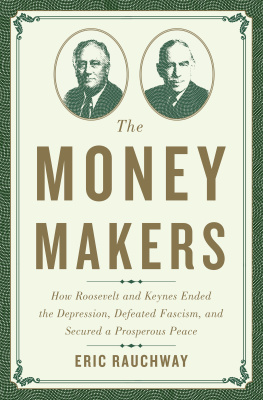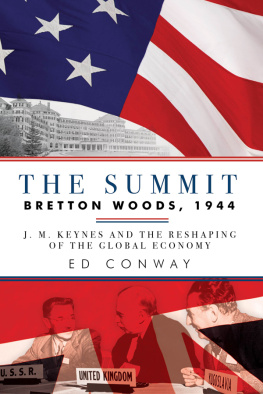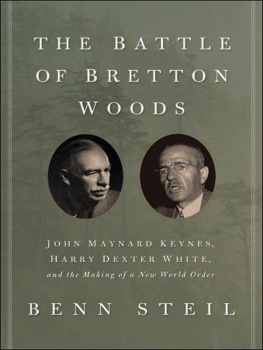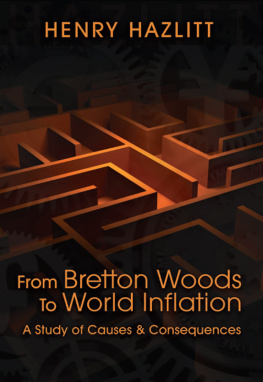THE BRETTON WOODS AGREEMENTS
Basic Documents in World Politics
Basic Documents in World Politics reproduces foundational documents that have had a major impact on the character and course of world politics, together with interpretive essays by major scholars. The essays, all previously unpublished, range over the historical context within which the documents were written and their evolving influence in shaping the contemporary world. The goal is to make the documents and controversies they have spawned accessible to newcomers, while contributing to scholarly debates about their meaning and significance.
Previous volumes in the series:
Charter of the United Nations, edited by Ian Shapiro and Joseph Lampert (2014)
Charter of the North Atlantic Treaty Organization, edited by Ian Shapiro and Adam Tooze (2018)
THE BRETTON WOODS AGREEMENTS
Together with Scholarly Commentaries and Essential Historical Documents
Edited and with an Introduction by
NAOMI LAMOREAUX AND IAN SHAPIRO

Copyright 2019 by Naomi Lamoreaux and Ian Shapiro.
All rights reserved.
This book may not be reproduced, in whole or in part, including illustrations, in any form
(beyond that copying permitted by Sections 107 and 108 of the U.S. Copyright Law and
except by reviewers for the public press), without written permission from the publishers.
Yale University Press books may be purchased in quantity for educational, business, or
promotional use. For information, please e-mail (U.S. office) or
(U.K. office).
Designed by Mary Valencia.
Set in Joanna and Eureka Sans type by Westchester Publishing Services.
Printed in the United States of America.
Library of Congress Control Number: 2018962180
ISBN 978-0-300-23679-8 (paperback : alk. paper)
A catalogue record for this book is available from the British Library.
This paper meets the requirements of ANSI/NISO Z39.48-1992 (Permanence of Paper).
10 9 8 7 6 5 4 3 2 1
Contents
Naomi Lamoreaux and Ian Shapiro
Jeffry Frieden
Barry Eichengreen
Douglas A. Irwin
James M. Boughton
Andrew Bailey, Gordon Bannerman, and Cheryl Schonhardt-Bailey
Michael J. Graetz and Olivia Briffault
Martin Daunton
Selwyn Cornish and Kurt Schuler
Eric Helleiner
Michael D. Bordo
Frances McCall Rosenbluth and James Sundquist
Harold James
.
Introduction
Naomi Lamoreaux and Ian Shapiro
O n July 1, 1944, less than a month after the D-Day landings in Normandy, delegates from forty-four nations gathered at a sprawling hotel near the base of Mount Washington in Bretton Woods, New Hampshire, to plan the postwar financial order. As the delegates debated the arcane details of a system of fixed but flexible exchange rates, Allied troops fought their way through France and battled island by island across the Pacific. US forces were sustaining heavy casualties on Guam when the conference ended three weeks later with agreement on two accords. One accord created the International Monetary Fund (IMF), and the other the International Bank for Reconstruction and Development (IBRD), progenitor of the World Bank.
The contrast between the life-and-death struggles of the war and the esoteric debates at the conference could not have been starker. At stake in both, however, was the kind of world that would take shape in the aftermath of the fighting. The battles determined which side would get the chance to remake the world, and by July of 1944 it was clear that victory would go to the Allies. But what the postwar world would look like was yet to be determined. The Bretton Woods accords, reproduced at the end of this volume, were part of the answer. The essays we have collected here revisit the accords, dry and opaque as they might seem at first glance to be, with the aim of recapturing the fears and tensions that shaped their provisions. The essays also examine alternative proposals that the assembly might have adopted, ideas whose time had passed or were yet to come. Dominated by the United States, the conference left many problems unresolved, many countries needs unmet, and these omissions would lead to the eventual collapse of the system. The fate of the Bretton Woods accords, the essays show, was as much bound up with what was not accomplished as with what was.
Dubbed the United Nations Monetary and Financial Conference, the gathering at Bretton Woods was the product of a series of planning conferences that began in Hot Springs, Virginia, in 1943 and culminated with a preconference meeting in Atlantic City, New Jersey, in June of 1944. Over the course of those meetings the scope of the discussion was increasingly narrowed. Although the initial Hot Springs conference addressed a broad set of development issues, by Bretton Woods the focus was on a single, core problem: designing a set of institutions to regulate the rates at which one nations currency could be exchanged for anothers.
However limiting the focus on exchange rates seemed to delegates interested in broader issues of development, the topic cut to the heart of how the world economy functioned. When people in Country A bought goods from Country B, they had to pay for them in Bs currency and effectively had to change their own money into Bs in order to do so. But what was a unit of As money worth in B units? One way of finding out was to let the market determine the exchange rate. If Country As currency was overvalued relative to Bs, producers in B would increase their exports to A, and consumers in B would decrease their imports from A, causing the value of As currency to fall. If Country As currency was undervalued, the reverse would happen. Unfortunately, this simple market solution was not always sufficient in practice because people did not only (or even mainly) buy goods on the spot. More often they bought goods on credit, for which payment came due sometime in the future. When transactions involved payments in the future, people needed to know what the exchange rate would be when their debts came due, not just in the present. The problem, however, was that governments could intervene in the market and take actions that affected the value of their currencies. Most obviously, they could inflate their money by printing more of it. Moreover, it was possible they would deliberately take such actions with the aim of reducing the burden of debt on their citizens (or themselves).
Historically, countries sought credibly to commit not to change the value of their currencies by pegging them to a particular amount of precious metalseither gold or silver or a combination of the two. As the volume of global trade increased in the late nineteenth century, more and more countries joined the club of advanced nations that fixed their currencies to a given quantity of gold. When they did so, they effectively promised to maintain reserves of gold (or of currencies like the British pound that were considered as good as gold) and allow holders of their currencies to redeem the bills at will at the fixed exchange rate. The only circumstances under which a country could break that promise without being ostracized from the club were major financial crises or wars. Then the country might suspend the convertibility of its currency, but only for the duration of the emergency.
The international gold standard worked reasonably well until the First World War. When the fighting broke out, the belligerent nations suspended the convertibility of their currencies. That was to be expected, but it was also to be expected that they would return to gold as soon as possible when the war ended. The serious financial turbulence that followed the peace, especially the disastrous postwar inflation that afflicted many countries on the European Continent, made a return to the gold standard both more difficult and more imperative. Although the return was largely accomplished by 1926, the world had changed, and the gold values of the major currencies were no longer appropriate to their countries altered positions in the world economy. As a result, the gold standard never worked the way it had before the war. It was now a drag on the economies of the countries that sustained it, particularly Britains, whose currency was now overvalued, and it came crashing down in the early years of the Great Depression. And as the gold standard collapsed, so did international trade.
Next page

